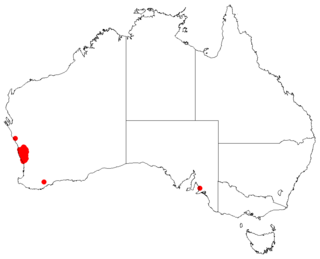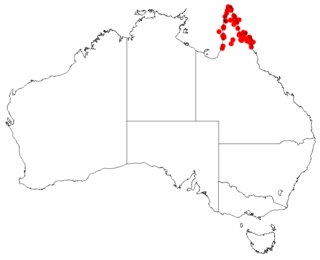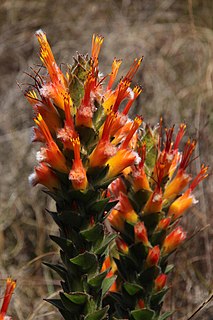
The Japanese roughshark is a rare species of shark in the family Oxynotidae, known only from a handful of specimens recovered from Suruga Bay and the Enshunada Sea off Japan. It is a benthic species that occurs at a depth of 150–350 m (490–1,150 ft). This shark is caught as bycatch by bottom trawlers throughout its entire limited range, and may be threatened given the declines in other bottom deep sea species in Suruga Bay.

Mortonia is a small genus of flowering shrubs known as saddlebushes, sand paper bush or mortonias. These are rough, hairy shrubs with leathery leaves and panicles of fleshy white to purplish flowers. They bear nutlets containing 1 seed each. They are native to the southwestern United States and northern Mexico, where they are most abundant in dry regions.

Hakea sericea, commonly known as bushy needlewood or silky hakea, is a large shrub with a profusion of mainly white flowers from July for several months. It is endemic to eastern Australia. It has become an environmental weed in some countries.

Ceanothus cordulatus is a species of shrub in the family Rhamnaceae known by the common names mountain whitethorn and whitethorn ceanothus. It is native to California and adjacent sections of Oregon, Nevada, and Baja California, where it grows on mountain ridges and other forested areas. This is a spreading shrub growing usually wider than tall and up to about 1.5 meters. The stems are gray, with the twigs yellow-green in color and fuzzy in texture when new. The evergreen leaves are alternately arranged and up to 3 centimeters long. Each is oval in shape with three ribs and generally not toothed. The leaves may be hairy or not. The inflorescence is panicle-shaped, up to about 4 centimeters long. The flowers are white to off-white with five sepals and five petals. The fruit is a rough, ridged capsule up to half a centimeter long. It has three valves inside, each containing a seed. It is a nitrogen-fixing plant, that is uniquely abundant in old-growth forest conditions when compared to similar types of nitrogen-fixing plants. In addition, Ceanothus cordulatus is known to be an important source of nitrogen patches for significantly longer times than other similar post-disturbance successional shrubs, following disturbance events such as forest fires.

Flindersia australis, commonly known as crow's ash, flindosy or Australian teak, is a species of tree that is endemic to north-eastern Australia. It has pinnate leaves with between five and thirteen egg-shaped to elliptical leaflets, white to cream-coloured flowers arranged in panicles on the ends of branchlets and followed by woody capsules studded with short, rough points and containing winged seeds.

Hakea undulata, commonly known as wavy-leaved hakea, is a shrub that is native to the south-west of Western Australia. It has stiff wavy leaves and fragrant cream-white flowers from mid-winter to October.

Saxifraga aspera is a species of saxifrage known by the common name of rough saxifrage. In German it is known as Rauhhaariger Steinbrech. It is placed in section Trachyphyllum of the genus Saxifraga. There are two subspecies, Saxifraga aspera subsp. aspera and Saxifraga aspera subsp. micrantha. It is a plant of the pan-Arctic tundra and is also found in Europe at moderately high altitudes in the Alps, Pyrenees and northern Apennines.

Hakea commutata is a shrub in the family Proteaceae native to Western Australia. A variable species in shape and growing requirements, including mallee heath, sand and along creek lines.

Hakea candolleana is a shrub in the family Proteaceae native to areas along the west coast in the Wheatbelt and Mid West regions of Western Australia. A cream-white winter flowering species, useful as a garden ground cover.

Hakea conchifolia, commonly known as the shell-leaved hakea is a shrub in the family Proteaceae native to an area in the west coast of the Wheatbelt region of Western Australia. An attractive small species with unusual rigid leaves that encircle the flowers.

Hakea cyclocarpa, commonly known as the ram's horn, wild bean or curved-fruit hakea is a shrub in the family Proteaceae. A strongly scented species with large creamy-white flowers with a red style and interesting fruit. Native to an area along the west coast and south west regions of Western Australia.

Hakea obtusa is a shrub in the family Proteaceae and is endemic to an area along the south coast in the Goldfields-Esperance regions of Western Australia. It has white and pink fragrant flowers in autumn and spring.

Hakea psilorrhyncha is a shrub in the family Proteacea native to a small area on the west coast in the Wheatbelt and Mid West regions of Western Australia.

Hakea smilacifolia is a shrub in the family Proteacea. It has sweetly scented flowers, stiff leathery leaves and is endemic to an area in the Mid West, western Wheatbelt and the Goldfields-Esperance regions of Western Australia.

Hakea stenocarpa is a shrub in the family Proteacea, commonly known as narrow-fruited hakea. It has scented creamy-white flowers in clusters, often with curling leaves and is endemic to an area in the Mid West, western Wheatbelt, Peel and the South West regions of Western Australia.

Hakea sulcata, commonly known as furrowed hakea, is a plant in the family Proteaceae that is endemic to Western Australia. It is a prickly shrub with grooved, cylindrical leaves, sweetly-scented flowers and relatively small fruit.

Hakea pedunculata is a shrub or small tree of the genus Hakea comprising approximately 150 species restricted to Australia. This species is found in the Far North region of Queensland and adjacent islands. Most Hakea seed are usually dispersed by an environmental trigger rather than when seed matures, quite often by fire. Whilst other species may require sporadic flooding rains to establish.
Grevillea scabra, commonly known as the rough-leaved grevillea, is a shrub of the genus Grevillea native to an area in the Wheatbelt region of Western Australia.

Mimetes capitulatus is an evergreen, upright, rounded shrub of about 2 m (7 ft) high, from the family Proteaceae. It has geyish green, lance- to egg-shaped leaves ending in a thickened tip. The flower heads and subtending leaves form a cylindric inflorescence, topped by ordinary, more or less upright leaves. Each primarily orange flowerhead contains 10–13 flowers with conspicuously scarlet styles, yellow under the narrow hourglass-like pollen presenter at its tip. Flowers can usually be found from mid-June till December, peaking in August. It is called conical pagoda in English and skraalstompie in Afrikaans.
Faurea galpinii is a small tree that grows to 10 m tall, but its trunks will vary depending on growing conditions. The leaves of F. galpinii are alternately lanceolate with wavy margins. When growing in the forest, the bark appears grey with smooth, concentric rings, although it can appear rough and dark under exposed conditions, and the variety Faurea gal pinii varies in size from 1 m to 2 m.


















